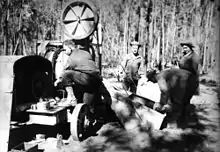Camp Cable


Camp Cable, Australia was a World War II army training base near Logan Village, Queensland, Australia.
The base was first known as Camp Tamborine but renamed in honour of Sergeant Gerald O. Cable.[1] Constructed in 1942 for the United States Army Forces in Australia (USAFIA), initially for the 32nd Infantry "Red Arrow" Division (United States) preparing for the New Guinea campaign, the base was occupied by various units during the war.[2] Part of the base was an area south of the Albert River for the 155th Station Hospital.[2][3]
Camp related entertainment was both local and from overseas. A picture theatre and tennis courts were built near the base Headquarters. American comedian Joe E. Brown performed at the 155th Station Hospital in 1943.[2] A song called Once upon a midnite was written at Camp Cable in 1943 for the show Here we go again, produced at the Theatre Royal, Brisbane, in 1944.[4]
A railway branch line to Canungra, operating from 1915–1955, passed through the base where its traffic peaked during the war. Timber getting and a slash pine plantation were the principal activities on the site of the former base after 1945.[5]
"Red Arrow" units
632 Tank Destroyer Battalion
In August 1942 the 632 TD Battalion moved to the then Camp Tamborine after training on antitank ranges at Camp Mangalore, Victoria. Training intensified with emphasis on beach defence and jungle warfare. On 21 December 1942 the battalion moved to Camp Strathpine near Petrie, Queensland.[6]
Post war
Yarrabilba development
In 2011 development began of the remaining land not previously subdivided for an urban precinct known as Yarrabilba.[7] Prior to 2012, a public park near the original main entrance of the base along Waterford-Tamborine Road included several memorials of remembrance. In 2012 these memorials were moved to the grounds of the Logan Village RSL, situated along Quinzeh Creek Road, to make way for the development's road works.[8]
Archaeological field school
The School of Social Science at the University of Queensland conducted its first archaeological field school in south-east Queensland at the former Camp Cable site in 2015. The site offers opportunities for field work on World War II history over an extended period, possibly around 10 years, depending on Yarrabilba's development. One aim is to excavate building remains for finds belonging to individuals present during the war era, which can be added to historical collections such as the Queensland Museum.[9]
References
- "Camp Cable". Peter Dunn's Australia at War. Retrieved 9 May 2012.
- "Camp Cable". Queensland WWII Historic Places. Department of Housing and Public Works, Queensland Government. Archived from the original on 31 July 2013. Retrieved 30 July 2013.
- "155th Station Hospital Unit History". WW2 US Medical Research Centre. Archived from the original on 2012-04-17. Retrieved 9 May 2012.
- McKinley, Sharon (2011). "Here we go again, stage musical, Brisbane, 1944". Sheet Music of the Week: Army Edition, September 29, 2011. Library of Congress. Retrieved 21 Jan 2013.
- "Yarrabilba". Logan Suburbs. Logan City Council. Retrieved 9 May 2012.
- "Organization History 632 Tank Destroyer Battalion" (PDF). TankDestroyer.net. Retrieved 19 February 2016.
- "Yarrabilba". Planning & Building. Logan City Council. Archived from the original on 2012-05-11. Retrieved 9 May 2012.
- "War relics moved as roadworks take over". Albert & Logan News. 7 November 2012. p. 17.
- Stiller, Samantha. "History being unearthed in Yarrabilba". Jimboomba Times. Retrieved 9 February 2016.
Further reading
- Gill, Bev (2002). Red Arrows, Green Pines. Logan Village, Queensland: B. Gill.
- Marks, Roger R. & Marks, A. Jenny (2006). Brisbane - WW2 v now : from an American archives' photo viewpoint. Vol. 20. Camp Cable, Canungra & Springbrook. with Peter Dunn. Mansfield, Queensland: R. & J. Marks.
- Wilson, Royce (18 April 2012). "Memorials pointers to area's rich history". Jimboomba Times. Beaudesert, Queensland, Australia. pp. 52–53.
External links
- Tambourine (sic) - Camp Cable area [plan number 1/T/296] (1945) NAA: BP378/1, FOLDER T FOLIO 76 National Archives of Australia (large jpeg image)
- Tamborine Hospital - Block Plan [1/T/296] (1943) NAA: BP378/1, FOLDER T FOLIO 74 National Archives of Australia (jpeg image)
- Tamborine - USA Hospital at Tamborine, Parish of Tamborine, County of Ward (survey plan) (1943) NAA: J1018, LS591 National Archives of Australia (jpeg image)
- Camp Cable on Facebook Logan Village RSL
- Camp Cable USA Memorial Cairn Queensland War Memorial Register
- Notables from Camp Cable Bootstrap Heritage